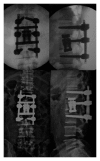Acute lumbar burst fracture treated by minimally invasive lateral corpectomy
- PMID: 23634314
- PMCID: PMC3619695
- DOI: 10.1155/2013/953897
Acute lumbar burst fracture treated by minimally invasive lateral corpectomy
Abstract
Burst fractures in acute spinal traumas are a difficult problem to solve. Different approaches and techniques have been utilized, but with high incidence of morbidity and mortality, besides unsatisfactory clinical and radiological results. Mini-open approaches recently emerged and have been shown to be safe and effective in the treatment of several spinal conditions. Here we report a case of acute lumbar burst fracture at L2 treated by minimally invasive true lateral approach posteriorly instrumented with percutaneous pedicle screws. The minimum disruptive access in addition to a rigid construction allowed a lumbar corpectomy without the morbidity of standard open approaches, lowering surgery costs and accelerating the patient recovery with successfully clinical and radiological results.
Figures




Similar articles
-
Minimally invasive corpectomy and posterior stabilization for lumbar burst fracture.Spine J. 2011 Sep;11(9):904-8. doi: 10.1016/j.spinee.2011.06.013. Epub 2011 Jul 29. Spine J. 2011. PMID: 21803000
-
Anterior corpectomy via the mini-open, extreme lateral, transpsoas approach combined with short-segment posterior fixation for single-level traumatic lumbar burst fractures: analysis of health-related quality of life outcomes and patient satisfaction.J Neurosurg Spine. 2016 Jan;24(1):60-8. doi: 10.3171/2015.4.SPINE14944. Epub 2015 Oct 2. J Neurosurg Spine. 2016. PMID: 26431072
-
Posterior keyhole corpectomy with percutaneous pedicle screw stabilization in the surgical management of lumbar burst fractures.Neurosurgery. 2007 Apr;60(4 Suppl 2):232-41; discussion 241-2. doi: 10.1227/01.NEU.0000255399.08033.B3. Neurosurgery. 2007. PMID: 17415158
-
Congress of Neurological Surgeons Systematic Review and Evidence-Based Guidelines on the Evaluation and Treatment of Patients With Thoracolumbar Spine Trauma: Novel Surgical Strategies.Neurosurgery. 2019 Jan 1;84(1):E59-E62. doi: 10.1093/neuros/nyy364. Neurosurgery. 2019. PMID: 30299485
-
Minimally invasive surgery for thoracolumbar spinal trauma.Ann Transl Med. 2018 Mar;6(6):102. doi: 10.21037/atm.2018.02.10. Ann Transl Med. 2018. PMID: 29707551 Free PMC article. Review.
Cited by
-
MIS lateral spine surgery: a systematic literature review of complications, outcomes, and economics.Eur Spine J. 2015 Apr;24 Suppl 3:287-313. doi: 10.1007/s00586-015-3886-1. Epub 2015 Apr 8. Eur Spine J. 2015. PMID: 25850387
-
Contribution of Round vs. Rectangular Expandable Cage Endcaps to Spinal Stability in a Cadaveric Corpectomy Model.Int J Spine Surg. 2015 Oct 22;9:53. doi: 10.14444/2053. eCollection 2015. Int J Spine Surg. 2015. PMID: 26609508 Free PMC article.
-
Technical nuances and approach-related morbidity of anterolateral and posterolateral lumbar corpectomy approaches-a systematic review of the literature.Acta Neurochir (Wien). 2022 Aug;164(8):2243-2256. doi: 10.1007/s00701-022-05240-8. Epub 2022 Jun 11. Acta Neurochir (Wien). 2022. PMID: 35689694 Free PMC article.
-
Minimally-invasive lateral thoracic and lumbar interbody fusion (LLIF) with expandable interbody cages - Considerations, complications & outcomes.Brain Spine. 2024 Jul 15;4:102870. doi: 10.1016/j.bas.2024.102870. eCollection 2024. Brain Spine. 2024. PMID: 39132256 Free PMC article.
-
Role of Lateral Fusion in Deformity Surgery.Int J Spine Surg. 2022 Mar;16(S1):S33-S43. doi: 10.14444/8234. Int J Spine Surg. 2022. PMID: 35387887 Free PMC article.
References
-
- Smith WD, Dakwar E, Le TV, Christian G, Serrano S, Uribe JS. Minimally invasive surgery for traumatic spinal pathologies: a mini-open, lateral approach in the thoracic and lumbar spine. Spine. 2010;35, supplement:S338–S346. - PubMed
-
- Sasso RC, Cotler HB. Posterior instrumentation and fusion for unstable fractures and fracture- dislocations of the thoracic and lumbar spine: a comparative study of three fixation devices in 70 patients. Spine. 1993;18(4):450–460. - PubMed
-
- Dai LY. Remodeling of the spinal canal after thoracolumbar burst fractures. Clinical Orthopaedics and Related Research. 2001;(382):119–123. - PubMed
-
- Verlaan JJ, Diekerhof CH, Buskens E, et al. Surgical treatment of traumatic fractures of the thoracic and lumbar spine: a systematic review of the literature on techniques, complications, and outcome. Spine. 2004;29(7):803–814. - PubMed
-
- Dimar JR, Fisher C, Vaccaro AR, et al. Predictors of complications after spinal stabilization of thoracolumbar spine injuries. Journal of Trauma. 2010;69(6):1497–1500. - PubMed
LinkOut - more resources
Full Text Sources
Other Literature Sources

